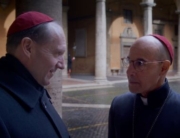
Based on the acclaimed 2011 novel by Bonnie Jo Campbell, Once Upon a River tries really hard to achieve a sort of self-reflective “journey into the American heartland” vibe, but ultimately it ends up feeling like a well-filmed scenic tour of rural Michigan, coupled with a narrative that comes off as inorganic and without substantive roles. Based on the convoluted source material, the script emphasizes plot, which there is a lot of, over character development as its protagonist experiences one vicious trauma after another.
It’s set in 1977 when a 15-year-old biracial girl, Margo Crane (Kenadi DelaCerna), embarks on an adventure down the fictitious Stark River to reunite with her mother, who is white—she left Margo and her Indigenous father some time ago “to find herself.” Along the way, Margo encounters a new flame, some friends, and an old guy named Smokes (John Ashton), who’s dying of lung cancer. There is also the unfinished and disturbing story line involving Margo and her probably-racist neighbors, a white school teacher and his two teenage sons. Their violent behavior toward Margo causes her to flee her small riverside town.
The majority of characters enter the story in revolving-door fashion throughout. We are introduced to one, who may offer a pontificating monologue and truism, and then we move onto another, making every interaction seem like another plot point to check off. Other than Margo’s father, there is only one other significant Indigenous person in the movie, Will (Ajuawak Kapashesit), and he is only there as a love interest. And despite Michigan having a significant Indigenous population, almost none are there to help Margo stand up for herself. The story instead focuses on the cliché musings of the rugged, individualist, white surrogate father, Smokes.
The location of a rural and decaying industrial Michigan—the slow-motion shots and pans of farmlands and landscapes—is surely worth exploring. But the adaptation comes off as a retrograde coming-of-age story where the majority of the ensemble mostly reacts and broods. Ultimately, viewers—and BIPOC teenagers, perhaps the target audience—need more than individualistic and demoralizing tales of suffering where the solution to all social troubles is simply to run.






Leave A Comment